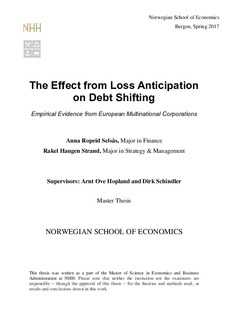| dc.description.abstract | This thesis examines whether multinational companies consider the anticipation of losses
when deciding upon their optimal capital structure and debt shifting strategies. It is
important to understand how capital is optimally allocated since multinationals want to
minimize their tax payments and tax authorities want to reduce the amount of tax avoidance.
Several papers have studied debt shifting as an instrument to minimize tax payments.
However, debt shifting strategies in loss-making affiliates have largely been ignored by both
academics and policymakers. To study if loss anticipation matters for firms’ capital
structure, we adjust the model for optimal capital structure of a multinational firm proposed
by Møen, Schindler, Schjelderup, and Tropina (2011), for a loss probability variable
introduced in Hopland, Lisowsky, Mardan, and Schindler (2015). Our model contains three
tax mechanisms and assumes inflexibility of firms to adjust their capital structure, meaning
that they have to decide on their debt shifting strategies ex-ante (before financial outcomes
are known). The model predicts that adjusting for loss probabilities should reduce the effect
the tax mechanisms have on the total debt-to-asset ratio of an affiliate. The predictions of our
model are then tested on a data sample of majority-owned affiliates of European
multinationals over the time period (2004-2014). Our empirical results suggest that the
standard debt tax shield is reduced when firms consider the likelihood of experiencing
losses. Furthermore, we find no evidence of internal debt shifting, while external debt
shifting increase. Our results show a substantial change in tax effects from including the loss
probability in our regressions, indicating that anticipation of losses does matter when firms
have to decide on their debt shifting strategies ex-ante. | nb_NO |
